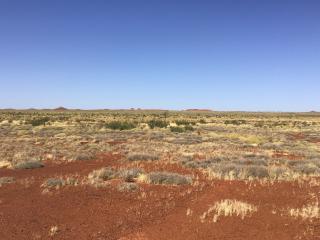
Ngururrpa means 'our Country in the middle'. It is a place where many stories and many different people come together. Ngarti, Kukatja, Walmajarri and Wangkajunka people are all represented by and have a say in how the Ngururrpa Indigenous Protected Area (IPA) is managed.
Ngururrpa Country is located in the far east of Western Australia's Pilbara region, in the Great Sandy Desert. Balgo community lies directly to the north, and Kiwirkurra to the south. The IPA covers the whole of the Ngururrpa Native Title Determination (exclusive possession was granted in 2007). It comprises an area of 29,717 square kilometres, and was dedicated by traditional owners in 2020.
Ngururrpa IPA comprises vast areas of sandplains and dunefields, interrupted by a series of ranges and mesas. The sandplains are vegetated with sparse Acacia shrubland over spinifex. While lateritic rises support small stands of Acacia hilliana. Ephemeral lakes and claypans are scattered across the IPA, some retaining water for extended periods. Key threatened fauna species that occur on the IPA include the ngalku (bilby, or Macrotis lagotis), tjalapa (great desert skink, or Egernia kintorei) and kakarratul (masupial mole, or Notoryctes sp.).
Ngururrpa sits within country in which some of the earliest evidence of human occupation in Australia has been found. Ancient creeks flow east from the ranges into seasonal swamps that make for fertile hunting and foraging areas. The many resources of food, shelter, wood, and water drew people together in hard times. These resources gave them the tools and food to live comfortably and practice ceremony for thousands of years. In the centre of Ngururrpa IPA, rock engravings have been recorded dating back over 12,000 years.
Today, Ngururrpa Rangers follow Tjukurrpa to manage country, including:
- how to look after plants and animals
- how and when to burn
- when and where food can be hunted and collected
- looking after other resources.
State: WA - Central and Southern region
Administration Organisation
Desert Support Services